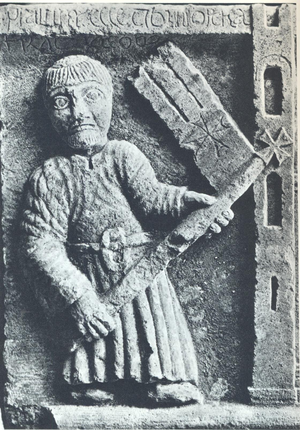| 1167 by topic |
|---|
| Leaders |
| Birth and death categories |
| Births – Deaths |
| Establishments and disestablishments categories |
| Establishments – Disestablishments |
| Art and literature |
| 1167 in poetry |


Year 1167 (MCLXVII) was a common year starting on Sunday of the Julian calendar.
Events
By place
Europe
- April 7 – Oath of Pontida: Supported by Pope Alexander III, the Lombard League is founded, a military alliance between the municipalities of Milan, Lodi, Ferrara, Piacenza and Parma, against the German invading forces of Emperor Frederick I (Barbarossa) in Northern Italy. The League (with other Italian cities) openly challenges Frederick's claim to power (Honor Imperii).
- April 12 – King Charles VII (Sverkersson) is murdered at Visingsö by supporters of Canute I (son of Eric IX), who proclaims himself king of Sweden. However, Charles's half-brothers Boleslaw and Kol Sverkerson proclaim themselves rulers of Östergötland, in opposition to Canute, which leads to fights for the power in Sweden (until 1173).
- May 29 – Battle of Monte Porzio: The army of the Commune of Rome is defeated by German forces under Frederick I and the local princes; Alexander III leaves Rome.[1] Frederick proceeds to Rome, where he is crowned by Antipope Paschal III for the second time. A sudden outbreak of pestilence kills many of his advisors and knights.[2]
- July 8 – Battle of Sirmium: Byzantine forces (15,000 men) under General Andronikos Kontostephanos defeat the Hungarians at Sirmium. Emperor Manuel I (Komnenos) consolidates his control over the western Balkans.
- August – Frederick I claims imperial authority over Bohemia, Greater Poland and Hungary. He installs his 3-year-old son Frederick V as duke of Swabia, after Frederick's cousin, Frederick IV, dies of disease at Rome.
Egypt
- March 18 – Battle of Al-Babein: A second Zangid army (some 12,000 men) under General Shirkuh and his nephew Saladin marches towards Egypt, but is met by the combined Crusader-Fatimid forces led by King Amalric of Jerusalem. After skirmishing down the Nile, the Crusaders are defeated near Giza and forced to retreat to Cairo.[3]
- May–June – Saladin leads the defence of Alexandria against the Crusader-Fatimid forces. He takes command over the garrison (plus some 1,000 cavalry), and the army's sick and wounded.[4]
- August 4 – Amalric I accepts a peace treaty and enters Alexandria at the head of the Crusader army. Saladin and his troops are escorted out with full military honours, and retreats to Syria.[5]
- Probable date – Battle of Pantina: The Byzantines intervene on behalf of Grand Prince Tihomir of Serbia against his rebellious brother, Prince Stefan Nemanja, who defeats the Byzantine forces and becomes Grand Župan of Serbia.
Ireland
- Diarmaid mac Murchadha (or Dermot), former king of Leinster, returns to Ireland with an advance party of Flemings under Richard fitz Godbert de Roche.
England
- King Henry II prohibits English students from attending the University of Paris; many settle at the University of Oxford.[6]
Asia
- Taira no Kiyomori becomes the first samurai to be appointed Daijo Daijin, chief minister of the government of Japan.
By topic
Religion
- Absalon, Danish archbishop and statesman, leads the first synod at Lund. He is granted land around the city of "Havn" (modern-day Copenhagen) and fortifies the coastal defence against the Wends.
Births
- February – Frederick VI, duke of Swabia (d. 1191)
- Anders Sunesen, archbishop of Lund (d. 1228)
- Warin II (the Younger), Norman knight (d. 1218)
- William I, count of Holland (Low Countries) (d. 1222)
Deaths
- January 12 – Aelred of Rievaulx, English abbot (b. 1110)
- February 27 – Robert of Melun, bishop of Hereford (b. 1100)
- April 12 – Charles VII (Sverkersson), king of Sweden (b. 1130)
- July 13 – Xia (Shenfu), Chinese empress consort (b. 1136)
- August
- August 14 – Rainald of Dassel, German archbishop (b. 1120)
- August 17 – Nicolò Politi, Italian monk and hermit (b. 1117)
- August 22 – Relindis of Hohenburg, French abbess
- September 10 – Matilda, Holy Roman Empress (b. 1102)
- Abraham ibn Ezra, Spanish philosopher (approximate date)
- Alaungsithu, Burmese king of the Pagan Dynasty (b. 1090)
- Basava, Indian philosopher and statesman (b. 1105)
- Christian I (the Quarrelsome), count of Oldenburg
- Euphrosyne of Polotsk, Kievan princess (b. 1104)
- Hugh of Poitiers, French monk and chronicler
- Occo of Schleswig (or Ogge), Danish bishop
- Raymond I (or Raimond), French nobleman
- Rostislav I, Grand Prince of Kiev (b. 1110)
References
- ^ Vigueur, Jean-Claude Maire (2010). L'autre Rome: Une histoire des Romains à l'époque communale (XIIe-XIVe siècle). Paris: Tallandier. p. 315. ISBN 978-2-84734-719-7.
- ^ Andrew Roberts (2011). Great Commanders of the Medieval World (454–1582), pp. 135–136. ISBN 978-0-85738-589-5.
- ^ Steven Runciman (1952). A History of The Crusades. Vol II: The Kingdom of Jerusalem, pp. 304–305. ISBN 978-0-241-29876-3.
- ^ David Nicolle (2011). Osprey: Command 12 - Saladin, p. 11. ISBN 978-1-84908-317-1.
- ^ Steven Runciman (1952). A History of The Crusades. Vol II: Kingdom of Jerusalem, p. 305. ISBN 978-0-241-29876-3.
- ^ Sager, Peter (2005). Oxford and Cambridge: An Uncommon History. London: Thames & Hudson. p. 36. ISBN 0500512493.









You must be logged in to post a comment.